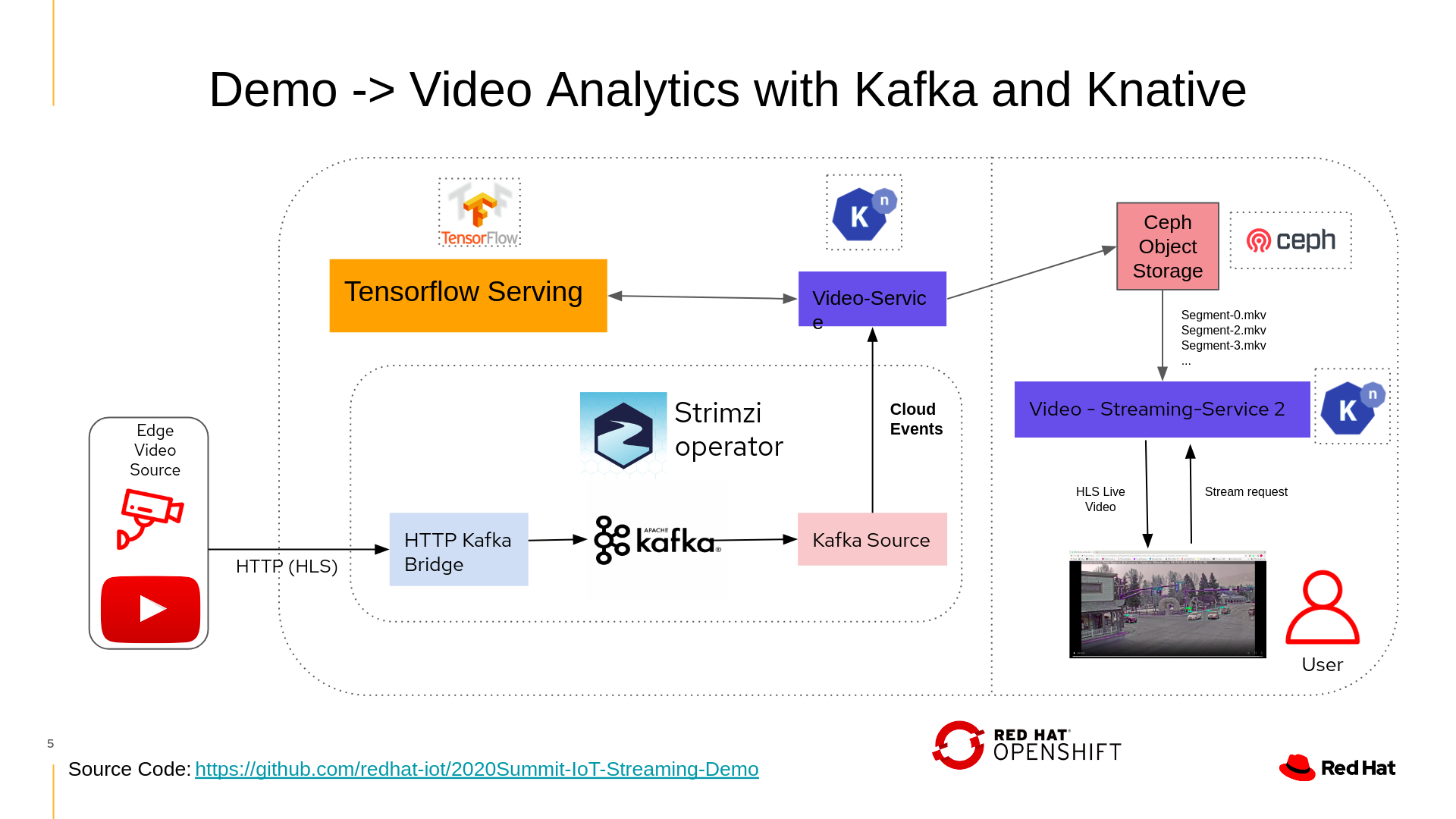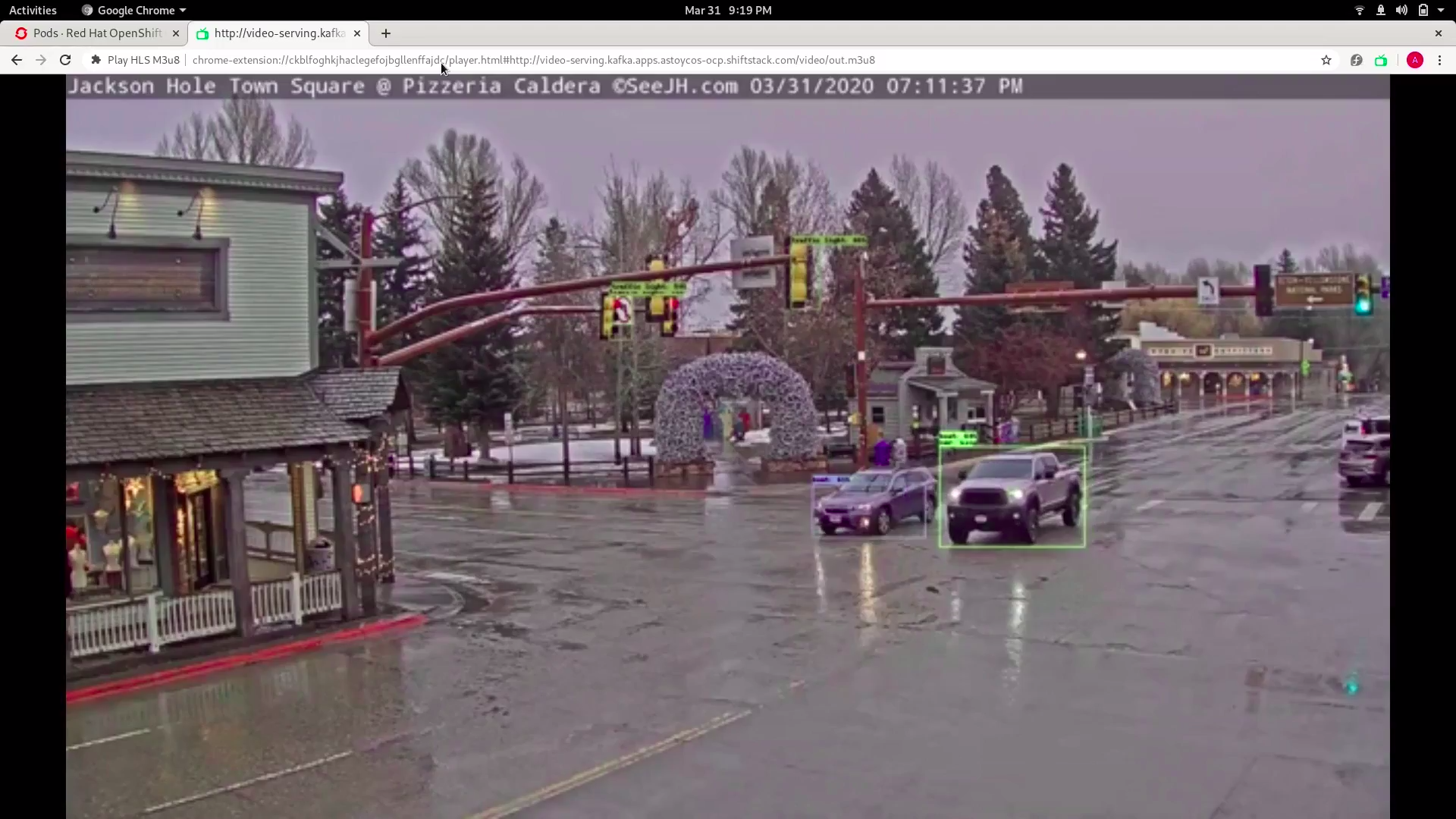2020Summit-IoT-Streaming-Demo
Live Streaming and Analytics Demo for 2020 Virtual Summit
It is split up into three major pieces
-
IoT Camera Simulator-> Pulls video from any youtube livestream and pushes it to the Kafka http bridge -
Analytics Service-> Gets live video data from kafka in the form of a Cloud Event, Sends the data to tensorflow-serving for inference, overlays the inference on the video, and uploads live video segments to ceph object storage -
Video Serving Service-> Pulls the live video stream segments from ceph, builds the HLS playlist file, serves the inferenced video to the user with a static flask based webapp
The overall system diagram and main components are shown below

Deploy this demo yourself
This POC demo uses some great cloud-native technologies, follow the instructions to spin it up on a personal cluster It can be deployed with the manual instuctions shown below or the Simple IoTCLI instuctions if using the IoTCLI command line tool
IoTCLI Install
Prerequisites For IoTCLI Install
-
An Openshift Cluster 4.3>
- For a quickstart Code ready containers may be used however they have not been tested with this system.
-
The latest IoTCLI download moved into yout
$PATH
Provision Knative
-
Run
IoTCLI knative setupwhich will setup knative eventing and serving on your cluster -
Check status with
IoTCLI knative setup --statusWhich should resemble the following
2020/04/24 15:14:00 knative Serving Install Status:
DependenciesInstalled==True
DeploymentsAvaliable==True
InstallSucceeded=True
Ready=True
2020/04/24 15:14:00 Context switched to namespace: knative-eventing
2020/04/24 15:14:00 NAME READY STATUS RESTARTS AGE
broker-controller-58fbf6569b-zgmz8 1/1 Running 0 12m
eventing-controller-5b9c5765dd-2w7cf 1/1 Running 2 12m
eventing-webhook-5cd6c688f4-7qzxw 1/1 Running 0 12m
imc-controller-845fc8776b-rcpzf 1/1 Running 0 12m
imc-dispatcher-5f9565cdbd-rmwlr 1/1 Running 0 12mProvision Kafka
-
Run
IoTCLI kafka setupto deploy kafka to your cluster with the strimzi Operator -
Deploy the http->kafka bridge with
IoTCLI kafka bridge -
Follow the Instructions to check status
To check status of Kafka HTTP bridge follow the prompt at the end of the install logs 'curl -v GET http://<your bridge route>/healthy'
Which should show
< HTTP/1.1 200 OK < content-length: 0 * Added cookie 9d04d3bd5bc37b277b860a02c6cf350d="69a5f362b53812ea1dbbee66d616958b" for domain my-bridge.io, path /, expire 0 < Set-Cookie: 9d04d3bd5bc37b277b860a02c6cf350d=69a5f362b53812ea1dbbee66d616958b; path=/; HttpOnly < Cache-control: private < * Connection #1 to host my-bridge.io left intact
Setup Ceph Object Storage
-
Run
IoTCLI ceph setupto provision ceph- BE PATIENT This will take some time for all the resources to become available
-
Run
IoTCLI ceph user <ceph username>to setup a new ceph user connected to credential storemy-store -
Run
IoTCLI ceph secrets <ceph username>to get the login secrets and ceph endpoint URL for your ceph instance, these will be used later.
Setup the Tensorflow Serving Deployments
- Run
IoTCLI tensorflowServing setup -n kafkaWhich will spin up the tensorflow serving pod
Deploy the Video Analytics knative service
- Run
IoTCLI knative service video-analytics -n kafka --cephEndpoint <Your Ceph Endpoint> --cephAccessKey <Your Ceph Access Key> --cephSecretKey<Your Ceph Secret Key>Setup the Kafka -> Knative Bridge
- Run
IoTCLI knative source kafka video-analytics -n kafka
Start the IoT Video Simulator
- Navigate to the
iotDeviceSimulator-kafkawithcd iotDeviceSimulator-kafka
- Set the
STREAMURLenvironment variable withexport STREAMURL=<Desired Youtube livestream>
- Set Kafka Bridge Endpoint for this demo as follows
export ENDPOINT=<kafka-bridge-endpoint>/topics/my-topic
- Start the Simulator
go run ./cmd
Deploy the video-serving service
-
Run
IoTCLI knative service video-serving -n kafka --cephEndpoint <Your Ceph Endpoint> --cephAccessKey <Your Ceph Access Key> --cephSecretKey<Your Ceph Secret Key>`to deploy the service
-
Run
IoTCLI service --statusto get the url for thevideo servingservice
NAME URL LATESTCREATED LATESTREADY READY REASON
video-analytics http://video-analytics.kafka.apps.astoycos-ocp.shiftstack.com video-analytics-895k8 video-analytics-895k8 True
video-serving http://video-serving.kafka.apps.astoycos-ocp.shiftstack.com video-serving-9cfps video-serving-9cfps True - Follow the final step instructions
Manual Install from Source
Prerequisites For Manual Install from Source
-
An Openshift Cluster 4.1>
- For a quickstart Code ready containers may be used however they have not been tested with this system.
-
Knative Eventing and Serving installed
- Knative Operator install instructions
- Knative Serving install instructions
- Knative Eventing install instructions
Setup Kafka with some custom modules
-
Create a namespace for the Apache Kafka installation
oc create namespace kafka
-
Install the Strimzi operator
curl -L "https://github.com/strimzi/strimzi-kafka-operator/releases/download/0.16.2/strimzi-cluster-operator-0.16.2.yaml" \ | sed 's/namespace: .*/namespace: kafka/' \ | kubectl -n kafka apply -f -
-
Configure the Kafka Cluster, with custom
max.message.bytes parameteroc apply -n kafka -f demo_yamls/kafka.yaml
-
oc apply -n kafka apply -f demo_yamls/kafka-bridge.yaml- Create a K8's Ingress Resource to access bridge from outside cluster
kubectl apply -f https://raw.githubusercontent.com/kubernetes/ingress-nginx/nginx-0.30.0/deploy/static/mandatory.yamlkubectl apply -f https://raw.githubusercontent.com/kubernetes/ingress-nginx/nginx-0.30.0/deploy/static/provider/cloud-generic.yamloc apply -f demo/yamls/ingress.yaml
-
Run
curl -v GET http://my-bridge.io/healthyto check bridge, output should be as follows:> GET /healthy HTTP/1.1 > Host: my-bridge.io:80 > User-Agent: curl/7.61.1 > Accept: */* > < HTTP/1.1 200 OK < content-length: 0
Setup Rook and Ceph Object storage
Follow Open Data Hub's instructions for Ceph installation with the Rook operator
And make sure to save the resulting s3 credentials
Deploy Tensorflow Serving
Do to the video inference the demo using a tensorflow-serving container with a pre-trained object detction model from the Model zoo library specifially using the ssd_inception_v2_cocossd_inception_v2_coco Model
-
To deploy this model simply run
oc apply -n kafka -f demo_yamls/tensorflow-deployment.yaml[astoycos@localhost 2020Summit-IoT-Streaming-Demo]$ oc get pods --selector=app=coco-server NAME READY STATUS RESTARTS AGE tensorflow-deployment-9d867d795-5q4kb 1/1 Running 0 2d4h
-
To Ensure the Serving pod is up run
oc get pods --selector=app=coco-serverIt should show the following
-
To get the podIP that will be used by the Knative Video Service Run:
export IP=$(oc get pods --selector=app=coco-server -o jsonpath='{.items[*].status.podIP'})
Deploy Knative Video Service
-
Apply your S3 Credentials and endpoint in
demo_yamls/video-service.yaml.in -
Apply the knative service with the environment configs run
cat demo_yamls/video-service.yaml.in | envsubst | oc apply -n kafka -f -
- Make sure the knative service is ready with
oc get ksvc Which should resemble the following
NAME URL LATESTCREATED LATESTREADY READY REASON
video-service http://video-service.kafka.apps.astoycos-ocp.shiftstack.com video-service-895k8 video-service-895k8 True - Deploy the Kafka-> Knative Source with
oc apply -n kafka -f demo_yamls/kafka-event-source.yaml
Now the Analyzed video stream segments should be stored in Ceph
Start the IoT camera simulator
- Navigate to the
iotDeviceSimulator-kafkawithcd iotDeviceSimulator-kafka
- Set the
STREAMURLenvironment variable withexport STREAMURL=<Desired Youtube livestream>
- Set Kafka Bridge Endpoint for this demo as follows
export ENDPOINT=my-bridge.io/topics/my-topic
- Start the Simulator
go run ./cmd
Deploy Knative Serving Service
-
Apply your S3 Credentials and endpoint in
demo_yamls/video-serving-service.yaml -
Apply the service with
oc apply -n kafka demo_yamls/video-serving-service.yaml
- Get the service URL with
oc get ksvc
NAME URL LATESTCREATED LATESTREADY READY REASON
video-serving http://video-serving.kafka.apps.astoycos-ocp.shiftstack.com video-serving-jsct5 video-serving-jsct5 True Move to Final Step instructions
Final Steps
Go to the a web browser and type in the video-serving service's URL. Add /video/out.m3u8 to the path for a final URL as follows
http://video-serving.kafka.apps.astoycos-ocp.shiftstack.com/video/out.m3u8
The following webpage will resemble the following, showing live video streaming an anlytics

Note:: You may need to add the service's URL to your etc/hosts file for correct DNS lookup